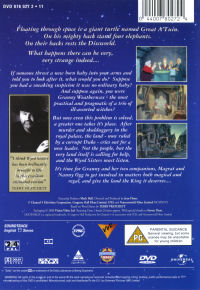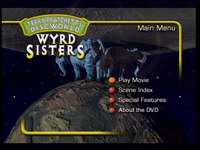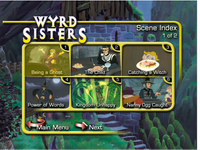
8.9.2010 #488
English Version 29.04.2013
by Guido Bibra
• Terry Pratchett Biography
• Wyrd Sisters Characters & Storyboards
• Discworld Bibliography
![]() The Series
The Series
The witches in the tiny kingdom of Lancre on the magical Discworld become involuntary involved into affairs of state, when King Verence is murdered by Duke Felmet and the heir of the kingdom, the King's baby son, is thrust into their hands. The strangest coven on the Discworld, consisting of patriarch Nanny Ogg, doyenne Granny Weatherway and up-and-coming Magrat Garlick, have no other chioce than to save the future of the kingdom with their very own methods...
For a long time Terry Pratchett's Discworld novels had been regarded as unfilmable and many attempts ended up in development hell. But in 2006 a group of filmmakers led by the director and scriptwriter Vadim Jean in close cooperation with the author managed the impossible and successfully adapted Hogfather as a two-part miniseries for Sky One. In 2008 a wonderful, if not completely true to the original adaptation of Pratchett's earliest Discworld stories The Colour of Magic and The Light Fantastic had been filmed and in 2010 the relatively new novel Going Postal was made as another amazing three-hour miniseries. But in the late 1990s, there had been a completely different approach to bring Terry Pratchett's Discworld universe to life.
When Terry Pratchett had more and more success with his Discworld novels in the 1990s, he had to deal with many offers from television and movie producers. Because his stories did not fit the Hollywood mainstream very well, only the British media remained, where the author found an unlikely collaborator: the Manchester animation studio Cosgrove Hall, which was founded in the 1970s and became very successful, conquering the television screens with cult series like Danger Mouse, Count Duckula and many others. In 1992 Cosgrove Hall had already produced a short stop-motion version of Pratchett's non-Discworld novel Truckers, which pleased the author very much - but the other two books of the so-called Bromeliad trilogy, Diggers and Wings, remained unfilmed.
The cooperation between Cosgrove Hall and Terry Pratchett was revived some years later, when the animation studio and the television station Channel Four became interested in his Discworld novels. As a test, a ten-minute pilot, based on the beginning of the novel Reaper Man, was produced in 1996, but this story was not further pursued, because not everything of the Discworld material was ideally suited for an animation treatment. Two books, however, proved to be exactly right for the project - one of them was Wyrd Sisters, Pratchett's sixth Discworld novel and the second story revolving around the witches of the Discworld and the little kingdom of Lancre.
The template for Wyrd Sisters were Shakespeare's historical dramas - Terry Pratchett had mainly used Macbeth and Hamlet as a basis, but he told the story as a brilliant genre parody, making the witches not the antagonists, but the heroes of the plot. The second half of the two stories, which were closely intertwined, was devoted to the evolution of theatre and acting on the Discworld, so it was actually less a sweeping fantasy parody than a small and subtle satire. It did not use too much phantastic elements and even sometimes left the impression of a small chamber play.
This was one of the reasons Cosgrove Hall had chosen Wyrd Sisters, because the simultaneously produced animated version of Soul Music was somewhat more elaborate. But Wyrd Sisters had not been neglected at all, the story was just much easier to implement. Terry Pratchett himself had declined to write the transformation of the book into a script for the four-part series with two and a half hours runtime himself, but instead left the task to the capable hands of Cosgrove Hall, who gave him full veto powers and took his advice with much gratitude. The script was written by Jimmy Hibbert, a long-time associate of the animation studio, who had orginally started as a voice actor before writing many teleplays for Cosgrove Hall since the late 1980s.
The majority of the 300-page-book had been carried over into the script, only a few subplots had to be reduced to fit the story into the given runtime. The plot, however, stayed intact and the essence of Terry Pratchett's extensive dialogue was preserved, although it had to be shortened as well. Surprisingly little had been left out and more importantly, the dark and mysterious atmosphere had not been jettisoned in favour of some simple children-orientated fun. Like the book, the script is quite humorous, but for an animated series unusually dramatic. Wyrd Sisters was directed by the long-time Cosgrove Hall animator Jean Flynn, who had already worked on many of their series before.
Visually, Wyrd Sisters only suffered little from the limited possibilities of a television production - the quality of the animation was on a surprisingly high level considering the circumstances. Especially the backgrounds were fitting representations of Terry Pratchett's imaginative world and although playful, they were not typically cartoonish. The same can be said about the characters, which were designed very close to the descriptions of the books and, besides a very dynamic animation, had very well developed facial expressions which are usually seen only in productions of a much higher calibre. No CGI help was used except in the title sequence, in which a digitally rendered Disc world complete with turtle and elephants are seen. For the technical developments in computer graphics at that time and the limited resources of a television budget this was a surprisingly well done representation.
The story was not only brought to life by the animation, but also by the brilliant casting. Cosgrove Hall did not only depend on their regular voice actors, but had engaged a group of first-class actors. Jane Horrocks, June Whitfield and Annette Crosbie all gave wonderful performances as the unconventional witch trio and infused Nanny Ogg, Granny Weatherwax and Magrat Garlick with exactly the right mix of humour and drama. Especially with these characters a lot could have gone wrong, making them too dumb or annoying - but even Jane Horrocks succeeded in playing the naive Magrat in an absolutely wonderful way.
David Holt played the slowly developing madness of Duke Felmet brilliantly and Eleanor Bron brought many detailed nuances of viciousness to the character of the Duchess, the actual antagonist of the story. For the dual role of the jester and Tomjon the comedian Les Dennis was hired, who had a lot of fun with his characters, but never crosses the line into complete sillyness. The crown jewel of the casting is, however, Death, for whom Cosgrove Hall was able to get none other than Christopher Lee. His short appearance in Wyrd Sisters is only a remnant of Soul Music, where he plays a much larger role, but even here he transforms his character with the help of his distinctive sonorous voice into something very special.
Musically, Wyrd Sisters had much more to offer than many other animated series, because not only short jingles were used, but a very elaborately produced background score. Tasked with this were Keith Hopwood, the former guitarist of Herman's Hermits and the composer and producer Phil Bush, who created a folk-like style with the help of orchestral arrangements, synthesizer sounds and acoustic guitars to fit the medieval atmosphere of the story and the Discworld. Especially the title tune, which was not only used for Wyrd Sisters, but also for Soul Music, has a very special sound, which was also utilized in many different variants for the background music, making it one of the most recognizable signatures of both series.
Wyrd Sisters had not only become a successful animated adaptation owing to the close cooperation with Terry Pratchett, but also through the competent work of Cosgrove Hall and the wonderful voice actors. Although it may just be an animated television series, Wyrd Sisters is far away from typical cartoon fare and was made much less for children than for adults. For those not familiar with the Discworld universe the story may be confusing, but fans of Terry Pratchett's work have a huge advantage and can enjoy one of the first successful Discworld adaptations.
![]() The DVD
The DVD
After a VHS release at the end of the 1990s, Wyrd Sisters and Soul Music had been released in England by Universal in 2000. The four episodes of the series had been spliced together as a 140-minute movie and were supplemented with a few, but interesting extras. Unfortunately the image quality was very disappointing, but apart from two American and German releases using the same image master this is the only DVD of this series.
The DVD of Wyrd Sisters reviewed in this article was part of a british double-pack together with Soul Music, in which the previously seperately discs were collected in a cardboard slipcase. Unfortunately, this british release is out-of-print at the moment and can only be bought second-hand. An alternative may be the German disc from KSM, but while it has the English soundtrack, it does not contain any of the extras of the UK release.


![]() Image
Image
Although Wyrd Sisters was only three years old at the time of the DVD's release, something went horribly wrong with the image quality. What is offered here looks suspiciously like a digitized VHS tape and compared to the quite good quality of Soul Music, seems to be a bad joke.
Even at first glance a very heavy noise is noticeable, which does not only make colour reproduction a huge problem, but also frays edges and blankets the whole image with a kind of analogue static. Bright image parts throw horizontal shadows and sometimes even large artifacts are visible - everything that can be expected from a vhs master. Moreover, the image is interlaced and cannot be properly played on a progressive display even with a capable de-interlacer, though the animation should have been produced at 25 frames per second like Soul Music.
As a consequence, sharpness is on an extremely below average niveau, because the noisy image swallows a lot of the not even particularly detailed animation. Even in closeups edges are fuzzy and elsewhere a lot is lost in the bad quality. But the authoring is not to blame for these faults - with an average bitrate of 5 mbit/s the compression does not make the unfavourable image quality any worse.
This DVD does not even look very good on an old tube television and is just about on the level of a vhs tape, although it won't wear out as fast. Mastered from a better source, Wyrd Sisters could surely look as good as Soul Music.
![]() Sound
Sound
In contrast to the dissapointing image quality the DVD of Wyrd Sisters at least has a decent soundtrack, which does not break any records, but has a lot to offer for an animated series.
The soundtrack is encoded in Dolby Digital 2.0 with 192 kbit/s and is listed as Stereo on the cover, but is actually a matrix-coded Dolby Surround mix. The surround channel is mainly used by the music, but is also called into action at some moments for some surprise sounds. The mix is not very elaborate, but is not only surround music with mono dialogue - the frontal soundstage is fully utilized by the sound effects and voices, which are not even always centered in the middle.
The overall sound quality cannot be faulted, even if the soundtrack was presumably mastered from a VHS tape - strong bass and solid trebles provide a solid sound and noise and other artifacts are not heard anywhere. Unfortunately there are no subtitles at all on this disc.
![]() Bonus Materials
Bonus Materials
The bonus materials of the Wyrd Sisters DVD are not particularly extensive, but have a few small surprises to offer. The menu design looks a bit amateurish and does not match the look of the series very good, but is at least well-structured.
Terry Pratchett contains five text screens about the author with a short biography.
Welcome to the Discworld (2:21) is the beginning of the short pilot film - the complete version can be found on the DVD of Soul Music.
Wyrd Sisters Characters introduces the protagonists of the story with nine short, but well-written biographies each containing three screens.
The Wyrd Sisters Storyboards are comprised of twelve scenes, but only one storyboard image each is shown.
Discworld Books contains the five-page Book List and three Selected UK Book Covers
Weblinks contains addresses of three websites, of which two of course have not existed for a very long time.

